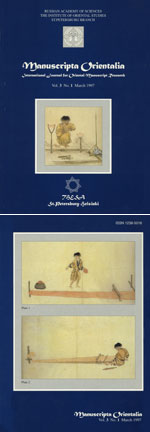|
|
| |

|

|
Vorobyova-Desyatovskaya M. Tibetan Eighth-Century Documents on Wood from Miran // Manuscripta Orientalia. Vol. 3. No. 1. March 1997. P. 9—13.
To reconstruct the history of East Turkestan in the eighth — ninth centuries it is necessary to take into account not only Chinese literary sources — official chronicles and documents, reports, memoirs of Chinese pilgrims, etc., but also documents written in the languages of the natives of the land, the aboriginal population of East Turkestan. Only in this way we can gain insight into political, social and economic relations of that time.
A considerable number of written sources of this kind have been introduced into circulation during the last years. The eighth-century Tibetan documents on wood considered in this article belong exactly to this group of written sources. Their introduction is important in many respects. First of all, these documents provide direct evidence on the lives of Tibetan garrisons in occupied territories, on all difficulties and problems they had to encounter. This material cannot be replaced by any chronicle. Second, these documents provide valuable information on the administration of the occupied territories, its bureaucratic institutions, on the system of accounts and management. The analysis of person and place names gives some idea on the ethnic composition of the Tibetan army as well as on the confessional association of its soldiers. The documents give the actual location of Tibetan garrisons on the territory of East Turkestan, the directions in which goods, mainly provisions, were transported; by the time required for their delivery one can estimate the distance between different garrisons and the practicability of the roads. Finally, these documents are the only and the earliest monuments of the Tibetan language of the seventh—ninth centuries. This language was close to the one spoken in daily life, not yet affected by the influence of other languages, like Sanskrit and Chinese, from which Tibetan pandits were beginning at that time to translate Buddhist scriptures.
The collection of Tibetan documents on wood (call number TD — Tibetan documents, TD-1—58) considered here is preserved in the Manuscript fund of the St. Petersburg Branch of the Institute of Oriental Studies of the Russian Academy of Sciences…
К содержанию выпуска...
 PDF-файлы PDF-файлы
Полный текст статьи
Ключевые слова
документы тибетские
коллекция ИВР РАН: издания
коллекция ИВР РАН: переводы
коллекция ИВР РАН: факсимиле
коллекция С.Е.Малова
Миран
фонд сериндийский
фонд тибетский
|
|
|
|
Случайная новость: Объявления |
|
14-15 ноября 2023 г. в ИВР РАН пройдет первая всероссийская научная конференция молодых востоковедов «Армия и военные традиции на Ближнем Востоке». Предлагаем вашему вниманию программу. |
|
Подробнее...
|
|
|
|
|

